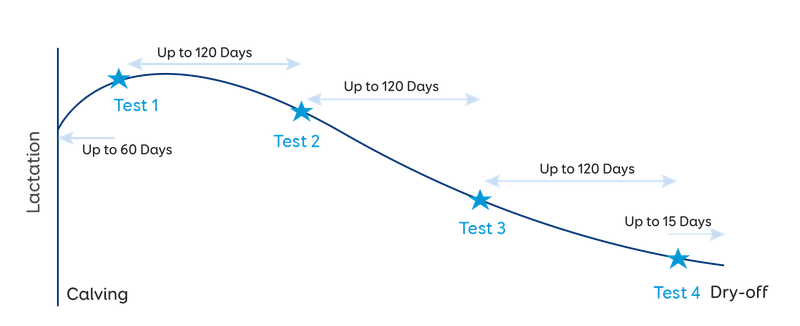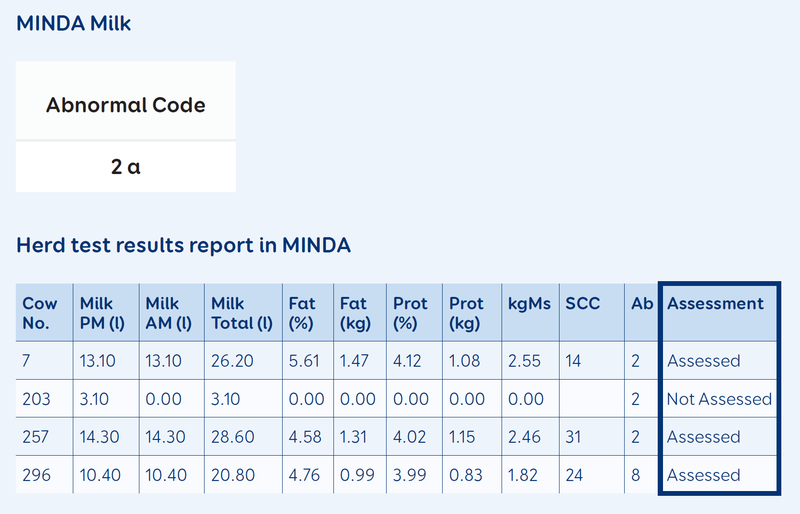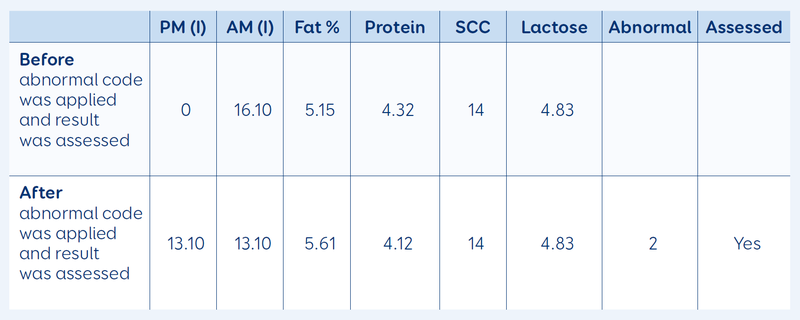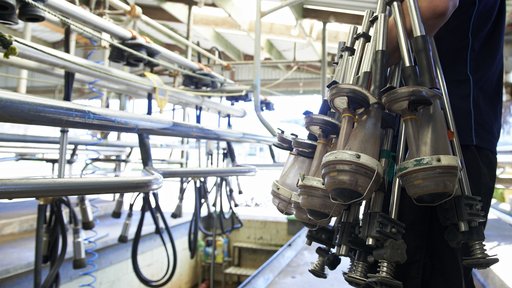Over the last two decades, herd sizes have increased, and the range of herd management practices have broadened. More recently, variable milking regimes have been on the rise which is providing greater flexibility and worklife balance. Alongside this, we have also seen an increased uptake of Single Sample herd testing (PM or AM only).
Whilst a single sample may be tempting for convenience on farm, data proves that twice-a-day milking regime with conventional “Classic” herd testing (PM/AM sampling) provides the most accurate information.
The graph below illustrates the impact herd testing sample regime has on the prediction of total yield (by product; Milk Fat, Milk Yield, Milk Protein). Showing accuracy for one, two, four and nine herd tests throughout a season, compared by one sample (AM or PM), or two sample PM and AM on a twice-a-day milking regime.

Summary of results:
- Twice-a-day milking regime with conventional “Classic” herd testing (PM/ AM, dark blue line) provides the most accurate data for predicting total yield, for all components, Milk Fat, Milk Yield and Milk Protein. In other words, this is the Gold Standard.
- Completing more herd tests increases the accuracy of prediction, with four herd tests per year needed to predict total yield for all components of more than 90%.
- If single sampling, a herd test collected in the morning (AM, light blue line) has consistently higher accuracy for all components than single sample collected in the afternoon (PM, grey line).
- Single sample herd test predicts Milk Fat with far less accuracy than Milk Yield or Milk Protein.
Herds that are Twice a Day (TAD) milking doing Single Sample herd testing, sampling at either the PM milking or AM milking, will receive derived results.
24-hour production figures will be calculated for each cow. The milking where a sample is not taken will show a derived result. Several factors are taken into account during this calculation, including the cows age, the stage within the lactation and the milking interval. Herd test reports and MINDA® will show which milking your sample was taken at and for which milking the data is derived.
Below is an example of how derived data is displayed in MINDA – the ‘d’ indicates that is the derived sample.

Difference between Labstrip & MINDA/herd test report:
With single sample test results, the labstrip’s somatic cell count, volume, fat & protein will be different from MINDA or the herd test report. This is because the labstrip will show you the raw data from your herd test without any calculations and MINDA will include the conversion to 24-hour production and derived information.
The accumulated lactation of an animal provides an accurate estimate of production over a season.
This is calculated by multiplying production data from herd tests over the season with days in milk.

We often get questions querying the days in milk and why they may appear to be less in our accumulated lactation calculation.
For all days in milk to be included in the accumulated lactation calculation, the herd test dates must align with these conditions:
- The first herd test is within 60 days of calving.
- The interval between herd tests does not exceed 120 days.
- The last herd test is no earlier than 15 days before the end of lactation.
Days in milk that fall outside of these conditions are not used when calculating the animal’s accumulated lactation.

Example
The total number of days in milk between calving and the dry-off date for the animal in the table below was 263 days. However, as the first herd test was 95 days from calving (instead of the recommended 60 days), 35 days in milk was subtracted, meaning only 228 days will be used to calculate the cow’s accumulated lactation.
263 days in milk – 35 days (days in milk that fall outside of conditions) = 228
Accumulated lactation
|
Dates |
Days in between |
|
|---|---|---|
|
Calving |
Dates 15/08/2020 |
|
|
1st test |
Dates 18/11/2020 |
Days in between 95 |
|
2nd test |
Dates 05/02/2021 |
Days in between 79 |
|
3rd test |
Dates 25/04/2021 |
Days in between 79 |
|
Dry off |
Dates 05/05/2021 |
Days in between 10 |
Frequently asked questions
Why are my days in milk lower than expected?
Days in milk that fall outside of our recommended conditions are excluded when calculating an animal’s accumulated lactation figures.
How can I see total number of days my animals have physically lactated?
This information is in MINDA® LIVE, by adding the ‘Days Lactating’ attribute to either groups or reports. This shows how many days the cow has been physically in milk for.
Will a loss of days in milk affect an animal’s indexes (BW, PW, LW)?
No, only test day information is used for animal evaluation.
Abnormal codes can be applied to an animal’s herd test results to ensure inaccurate data isn’t sent to the New Zealand Dairy Industry Good Animal Database (DIGAD) for animal evaluation.
If a result is not a true representation of what an animal would normally produce the following codes can be applied by the farmer in EZ Link® or on the test card:
2 – Farm anomaly – spilt/mixed/missed test
3 – In season
4 – Held milk
7 – Run with calves
8 – Sick
The following codes can be applied by LIC – either in the field or in the Lab during processing of the samples:
1 – Insufficient sample (Minimum sample limits)
5 – Herd tester processing anomaly
9 – Contaminated sample
By adding an abnormal code, it means the result will not have any impact on indices (BW/PW/LW) – for example if a sample is spilt the cow will have a small or no sample. If an abnormal code 2 is applied the herd test result will not change her indexes and make her look to be performing poorly compared to others in the contemporary group.
Assessed results
When an abnormal code is applied the animal may get an assessed result. The assessed result will be based off the other normal herd tests the animal has had during the season.
There are a couple of rules that contribute towards whether a result will be assessed or not – animals with an abnormal test recorded will be assessed if:
- There is at least one normal herd test for the animal at the location during the same season
- The date of the abnormal herd test is within 305 days of the animals last calving date
Farmers can see if a result has been assessed by the ‘a’ icon in MINDA® Milk or adding the “Assessment” attribute on the herd test report– see examples below:

The example below demonstrates an animals’ herd test result before an abnormal code was applied and after the result was assessed. This herd was milking twice-a-day, doing a Classic Sample herd test (samples taken at both PM/AM milkings), the PM sample for this animal was dropped on farm and the farmer subsequently assigned abnormal code 2, Farm anomaly, against the animal.
Volume, Fat percentage (%) and Protein percentage (%) have assessed based off this animal’s normal herd test/s in the lactation. You will notice total volume has split evenly across the PM and AM sessions. The assessed result may reassess and change if other tests come in for the lactation.

Note: The abnormal code will ensure the animals indices (BW/PW/LW) are not impacted and the assessed calculation above can be used to better predict accumulated lactation.
Towards the end of the milking season, milk production reduces. For herd testing to provide a result, the sample needs to meet a minimum of 22ml, which equates to 4L per animal. If your animals are producing less than this and a test result cannot be attained, your samples will be given an abnormal code 1 (insufficient sample).
If you’re planning to herd test towards the end of the season we encourage you to undertake a classic two sample (PM & AM) test to ensure the best chance of having sufficient volume to get a result.
Herd testing information can be used later in the season to identify cows to dry off early. DairyNZ SmartSAMM guide recommends animals producing less than 5L are dried off.



